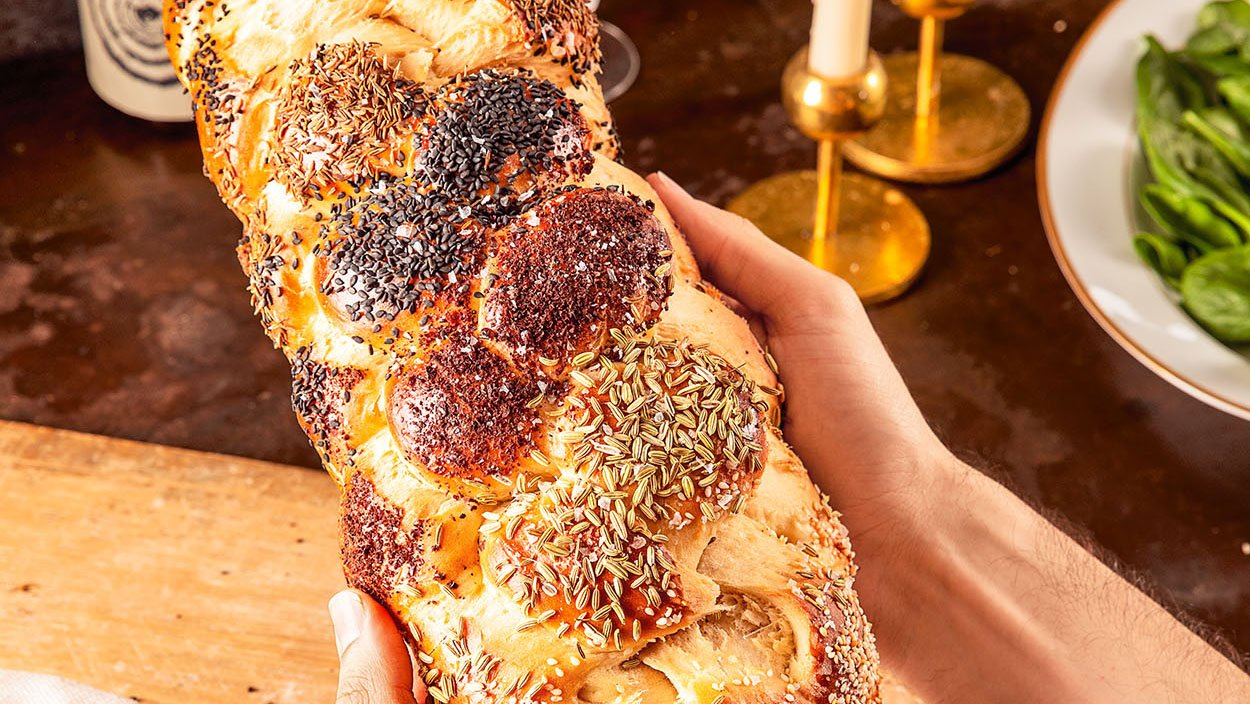
Nothing melts away the craziness of a week like tearing into a warm, freshly baked challah. We don’t technically need to dive into why it’s the best bread, but we will. It’s fluffy and tender, with the perfect balance of sweetness and salinity. It’s also highly versatile: not only is it the star of the Shabbos table, but it frequently makes cameos as French toast, sandwich bread, and even the occasional hot dog bun. It’s simply a superior loaf! But beyond the enjoyment we get from eating it lies the true beauty in what it represents on the table. It symbolizes nourishment and allows us to reflect on our gratitude for being nourished. Also, it is customary to serve two loaves to symbolize abundance. Finally, challah is meant to be ripped with one’s hands and passed around. This experience of physically breaking bread with others connects everyone around the table, turning strangers into friends and friends into family.

Jake’s Perfect Challah
Equipment
- Stand mixer
Ingredients
- 1 cup water, heated to 115°F
- 1/2 cup (100g) granulated sugar
- 1 (¼ -ounce) packet active dry yeast (2¼ teaspoons)
- 6 tablespoons vegetable oil
- 1/4 cup honey
- 4 large eggs
- 5 1/2 to 6 cups (745g to 810g) all-purpose flour, plus more for dusting
- 2 teaspoons kosher salt
- 1 1/2 teaspoons assorted seeds, such as sesame, fennel, poppy, nigella, and/ or cumin, for garnish
- Flaky sea salt, for garnish
Instructions
- In the bowl of a stand mixer fitted with the whisk attachment, mix the warm water and 2 tablespoons of the sugar to dissolve, then sprinkle the yeast over the top. Let stand until foamy, 5 to 10 minutes. Add the remaining 6 tablespoons sugar, 4 tablespoons of the vegetable oil, honey, and 3 of the eggs, then whisk on medium speed until incorporated.
- Switch to the dough hook. Add 5½ cups flour and the salt to the mixture in the bowl and, beginning on low speed and gradually increasing to medium, knead until a smooth, elastic dough forms, 3 to 4 minutes. (Your dough will be tacky but shouldn’t be sticky. If it’s sticky, mix in additional flour, a few tablespoons at a time, until tacky.) Transfer to a lightly floured work surface with floured hands and continue to knead by hand, dusting with flour as needed, until a very smooth ball forms, another 3 to 5 minutes. (Alternatively, if you make this dough entirely by hand, it will require about 10 minutes of kneading on a clean work surface after incorporating the flour.) Grease a medium bowl and your hands with the remaining 2 tablespoons of vegetable oil and add the dough ball, turning gently to coat. Cover with plastic wrap or a kitchen towel and set aside in a warm place until doubled in size, 1½ to 2 hours.
- Transfer the dough to a clean work surface and divide into 6 equal pieces. Roll each into a long rope, about 18 inches in length and slightly thicker at the center and thinner at both ends. Lay out all the ropes vertically, then link the top of each rope and pinch together to seal, tucking the sealed end under itself slightly.
- Take the outer two ropes and cross them over each other to switch places, crossing the rope from the right under the rope from the left. Take the farthest rope on the right and cross it over to be in the middle (with 3 ropes on the left of it and 2 ropes on the right). Then, take the second rope from the left and cross it all the way to the far right. Now, take the farthest rope to the left and move it to the middle (with 2 ropes on the left of it and 3 ropes on the right). Take the second rope from the right and cross it all the way to the far left. Repeat this process until there are no more ropes to braid, then pinch the ends and tuck them under the end of the challah. (See instructions below.) Using your hands, carefully transfer the challah to a parchment-lined half sheet pan, placing it on a diagonal.
- Beat the remaining egg and brush liberally on the challah. Let the challah rise again, uncovered, until doubled in volume, about 1 hour.
- Preheat the oven to 350°F.
- Brush the challah again with the remaining beaten egg, then sprinkle with the seeds and a heavy pinch of flaky salt.
- Bake, rotating the pan halfway through the cooking time, for 35 to 40 minutes, until the challah is golden brown and has reached an internal temperature of 190°F. Remove from the oven and let cool completely before slicing. Serve the challah the same day you bake it.
TO BRAID
- Lay out all the ropes vertically, then link the top of each rope and pinch together to seal, tucking the sealed end under itself slightly.
- Take the outer two ropes and cross them over each other to switch places, crossing the rope from the right under the rope from the left.
- Take the farthest rope on the right and cross it over to be in the middle (with 3 ropes on the left of it and 2 ropes on the right).
- Take the second rope from the left and cross it all the way to the far right.
- Take the farthest rope to the left and move it to the middle.
- Take the second rope from the right and cross it all the way to the far left.
- Return to step 3 and repeat until all the dough is braided, then pinch the ends to seal and tuck the sealed end under.
Notes
 From Jew-ish by Jake Cohen. Copyright © 2021 by Jake Cohen. Reprinted by permission of Harvest, an imprint of HarperCollins Publishers.
From Jew-ish by Jake Cohen. Copyright © 2021 by Jake Cohen. Reprinted by permission of Harvest, an imprint of HarperCollins Publishers.

